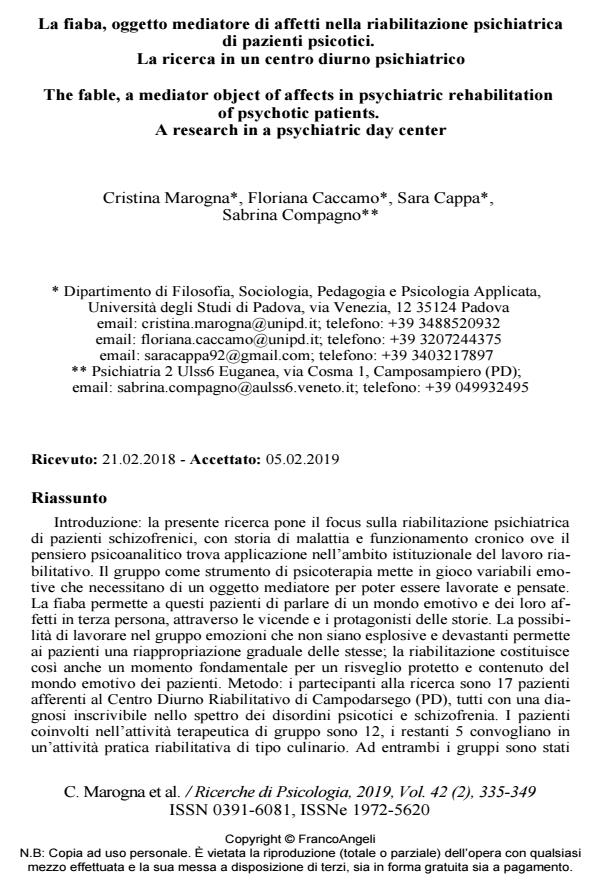The fable, a mediator object of affects in psychiatric rehabilitation of psychotic patients. A research in a psychiatric day center
Journal title RICERCHE DI PSICOLOGIA
Author/s Cristina Marogna, Floriana Caccamo, Sara Cappa, Sabrina Compagno
Publishing Year 2019 Issue 2019/2
Language Italian Pages 15 P. 335-349 File size 174 KB
DOI 10.3280/RIP2019-002006
DOI is like a bar code for intellectual property: to have more infomation
click here
Below, you can see the article first page
If you want to buy this article in PDF format, you can do it, following the instructions to buy download credits

FrancoAngeli is member of Publishers International Linking Association, Inc (PILA), a not-for-profit association which run the CrossRef service enabling links to and from online scholarly content.
The present research sets the focus on the psychiatric rehabilitation of schizophrenic patients, with history of illness and chronic operation where the psychoanalytic thought finds application in the institutional contest. The group as a tool of psychotherapy it risks emotional variables that need a mediator object to be able to be worked and to be thoughts. The fable allows these patients to speak of an emotional world and of their affections to third person, through the stories and the protagonists of the histories. The possibility to work in the group emotions that aren’t explosive and devastating allows the patients a gradual repurchase of the same; the rehabilitation so also constitutes a fundamental moment for a protected and contained awakening. Method: the participants at the research are 17 patient attendance to the Psychiatric Day-Care Center of Campodarsego (PD), all with a diagnosis in line with the ghost of the psychotic disorders and schizophrenia. The patients involved in the therapeutic activity of group are 12, the remainders 5 carry in a practical rehabilitative activity as culinary type. To both the groups have been administered the same questionnaires, FATAS-G and Tas -20. Results: the therapeutic factors of the cohesion and the corrective recapitulation that are activated in the group of oral therapy create a specific ground that makes the therapeutic space a transitional area whether it’s possible to play thoughts and affections. The use of a transitional object as the fable shows useful in the psychosis’s therapy because it allows the patients to bring not expressible emotional elements in first person and to put in history and word an incandescent emotional world. This is shown by the fact that the total score at the questionnaire Tas-20 related to the alexithymia it gets a lowering of the value of the total score and at the first factor, difficulty to identify the feelings, between the first one and the second administration.
Keywords: Group psychotherapy, mediator object, psychosis, psychiatric rehabilitation, Psychiatric Day-Care Center.
Cristina Marogna, Floriana Caccamo, Sara Cappa, Sabrina Compagno, La fiaba, oggetto mediatore di affetti nella riabilitazione psichiatrica di pazienti psicotici. La ricerca in un centro diurno psichiatrico in "RICERCHE DI PSICOLOGIA " 2/2019, pp 335-349, DOI: 10.3280/RIP2019-002006